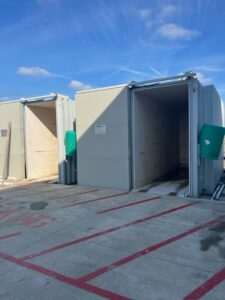Vacuum Cooling
Vacuum cooling is a fast and energy-efficient method for chilling food and extending its shelf life. Now H&E is using this same technology that has been a success in the food industry in extending the shelf life of turfgrass. In the fight to reduce waste and keep turfgrass fresh, cooling is an important weapon. Reducing the temperature of the turf increases its shelf life, slows the growth of bacteria that might otherwise cause it to spoil.
 Traditional cooling methods use either air or water to remove heat via a combination of conduction and convection. Using water to cool turf isn’t an option due to the fact you will end up with mud balls. Conventional cooling also produces an uneven temperature distribution, with food products at the edges of containers being cooled more quickly than those at the center. And of course, the process is very energy intensive. An alternative is to cool by placing it in a vacuum chamber. Vacuum cooling is based on the principle of evaporation: as water evaporates from the product, energy is removed, and the temperature drops. The evaporation process begins as soon as the pressure falls low enough for water to boil, and the desired final temperature can be set by controlling the pressure in the vacuum chamber. Compared to conventional cooling, vacuum cooling is fast. With the right equipment, a pallet of sod that would take several hours to cool via forced air circulation can be chilled within a few minutes. Vacuum cooling is efficient, too, requiring a quarter of the energy of forced-air cooling. Another advantage is that because evaporation takes place on all surfaces at the same time, the spatial distribution of the cooling is homogenous. This gives vacuum-cooled products a significantly longer shelf life. The requirements of cooling grass are similar to those for cooling vegetables, except that the amount of water that must be extracted to reach the desired temperature is significantly higher, due to the mass of the product (including soil and mud). It is therefore a more demanding job for the vacuum pump.
Traditional cooling methods use either air or water to remove heat via a combination of conduction and convection. Using water to cool turf isn’t an option due to the fact you will end up with mud balls. Conventional cooling also produces an uneven temperature distribution, with food products at the edges of containers being cooled more quickly than those at the center. And of course, the process is very energy intensive. An alternative is to cool by placing it in a vacuum chamber. Vacuum cooling is based on the principle of evaporation: as water evaporates from the product, energy is removed, and the temperature drops. The evaporation process begins as soon as the pressure falls low enough for water to boil, and the desired final temperature can be set by controlling the pressure in the vacuum chamber. Compared to conventional cooling, vacuum cooling is fast. With the right equipment, a pallet of sod that would take several hours to cool via forced air circulation can be chilled within a few minutes. Vacuum cooling is efficient, too, requiring a quarter of the energy of forced-air cooling. Another advantage is that because evaporation takes place on all surfaces at the same time, the spatial distribution of the cooling is homogenous. This gives vacuum-cooled products a significantly longer shelf life. The requirements of cooling grass are similar to those for cooling vegetables, except that the amount of water that must be extracted to reach the desired temperature is significantly higher, due to the mass of the product (including soil and mud). It is therefore a more demanding job for the vacuum pump.
